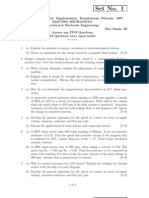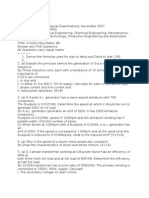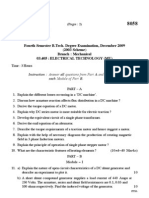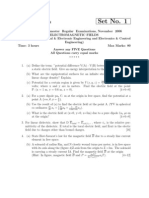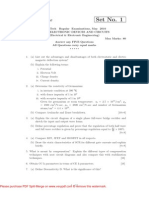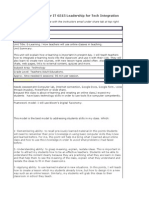5 Em-1
5 Em-1
Uploaded by
29viswa12Copyright:
Available Formats
5 Em-1
5 Em-1
Uploaded by
29viswa12Original Title
Copyright
Available Formats
Share this document
Did you find this document useful?
Is this content inappropriate?
Copyright:
Available Formats
5 Em-1
5 Em-1
Uploaded by
29viswa12Copyright:
Available Formats
Code No: W0221/R07 II B.
Tech I Semester (R07) Regular Examinations, Nov- 2010 ELECTRICAL MACHINES - I (Electrical and Electronics Engineering) Time: 3 hours Answer any FIVE Questions All Questions carry equal marks 1.
SET - 1
Max Marks: 80
a) State the principle of conversion of energy and apply it to an electric motor as electromechanical conversion device? (8M) b) Derive the expression for the energy stored in the magnetic field for singly excited electromechanical system? (8M) a) Discuss the function of commutator along with its constructional details giving suitable diagrams. (8M) b) A 4 pole lap connected dc generator having 50 slots on its armature with 6 conductors per slot, the flux per pole 30 mWb and generates an open circuit voltage of 180 V. (i) Find the speed at which the motor will run for the above condition, (ii) keeping the speed constant, suggest a change in the armature of the generator such that the generator is capable to generate at no load a voltage of 90 V, with the same rated flux. (8M) a) What is meant by armature reaction? Briefly describe that the effect of armature mmf on the main field is entirely cross magnetizing? (8M) b) A 50 kW, 400V, 6-pole dc generator has 720 lap wound conductors. The brushes lead of 2.5 angular degrees (mech.) from the geometric neutral. Calculate the cross and demagnetizing turns per pole. Neglect the shunt field current. (8M) a) Explain with suitable diagrams (8M) i) Critical resistance of the field circuit of the shunt generator ii) Critical speed of the generator. b) A separately excited dc generator has armature circuit resistance of 0.1 and the total drop at the brushes is 2V. When running at 1000 rpm, it delivers a current of 100A at 250 V to a load of constant resistance. If the generator speed drops to 700 rpm, with field current unaltered, find the terminal voltage and current delivered to load? (8M) a) Draw the load characteristics of shunt, series and compound generators? Describe these characteristics nature and applications? (8M) b) Two Shunt-wound generators running parallel each have an armature resistance of 0.03 and field resistance of 60 . The combined external load current is 4500 A. The fields of the generators are so excited that the electromotive force induced in the one machine is 500 V and in the other machine is 510 V. Calculate the bus bar voltage and output of the each machine? (8M) 1 of 2
2.
3.
4.
5.
Please purchase PDF Split-Merge on www.verypdf.com to remove this watermark.
Code No: W0221/R07
SET - 1
6.
a) Derive the expression for torque developed by the dc motor using BIl concept? (8M) b) A 220 V dc shunt motor takes no load current of 10 A and runs at 1500 rpm. At full load the armature current is 100 A and the motor runs at 1470 rpm. Resistance of the armature is 0.1 calculate the following (i) back emf at no load and full load and (ii) percentage of reduction in flux due to armature reaction (8M) a) Describe and compare the various methods of speed control of dc motors? (8M) b) A 440 V dc series motor a regulating resistance of R in series. The motor resistance is 0.3 . When R = 0 and the current I is 20 A, the motor runs at 1200 rpm. Find the speed when R=3 and I =15A. Also find the ratio of total mechanical output in two cases. Given that the flux with I = 15A is 80 % of that with I = 20A. (8M) a) Draw and discuss analytically, the shape of the efficiency curve of a shunt motor. Determine the condition for maximum efficiency? (8M) b) Describe with suitable diagram of Fields Test to find the efficiency of dc machine as a motor and as a generator? (8M)
7.
8.
2 of 2
Please purchase PDF Split-Merge on www.verypdf.com to remove this watermark.
Code No: W0221/R07 II B.Tech I Semester (R07) Regular Examinations, Nov- 2010 ELECTRICAL MACHINES - I (Electrical and Electronics Engineering) Time: 3 hours Answer any FIVE Questions All Questions carry equal marks 1.
SET - 2
Max Marks: 80
2.
3.
4.
5.
a) Derive an expression for the field energy stored in doubly excited electromechanical system. (8M) b) Show that the torque developed in doubly excited magnetic system is equal to the rate of increase of field energy with respect to displacement at constant currents (8M) a) Describe the constructional details of the armature of a dc machine giving suitable diagrams? (8M) b) A 4 pole wave connected dc generator having 60 slots on its armature with 6 conductors per slot, runs at 750 rpm and generates an open circuit voltage of 230 V. i) Find the useful flux per pole needed for the above condition, ii) keeping the flux constant, suggest a change in the armature of the generator such that the generator is capable to generate at no load a voltage of 115 V, when running at same speed. (8M) a) What is meant by ideal commutation? Describe the difference between actual commutation and ideal commutation? (8M) b) A 4-pole dc generator supplies a current of 143A. it has 492 armature conductors (i) wave connected (ii) lap connected. When delivering full load, the brushes are given an actual lead of 100. Calculate the demagnetizing armature ampere turns per pole. The field winding is shunt connected and takes 10A. Find the number of extra shunt field turns necessary to neutralize the demagnetization? (8M) a) A shunt generator, when driven at its normal speed, fails to self excite. Discuss the reason for this, and state various conditions for the buildup of voltage? (8M) b) The open circuit characteristics of a dc shunt generator driven at 1000 rpm is as follows Field current (A): 0 1 2 3 4 6 8 10 Emf (V) : 4 115 230 315 360 405 430 450 Based on the above, Calculate i) The emf to which the machine will excite with shunt field resistance of 50 . ii) The additional resistance in the field circuit to reduce the emf to 392 V. iii) Critical resistance of shunt field circuit at 600 rpm. (8M) a) Explain how the external and internal characteristics of the dc shunt generator can be obtained practically. (8M) b) Two shunt generators are running parallel to supply a load of 5000A. Each machine has a field resistance of 50 and armature resistance of 0.02 . The emf generated is 600 V and 610 V respectively. Find the bus bar voltage and kilowatt output of the each machine. (8M) 1 of 2
Please purchase PDF Split-Merge on www.verypdf.com to remove this watermark.
Code No: W0221/R07 6.
SET - 2
a) Why the emf induced in dc motor is called as back emf and then explains principle of operation of dc motor? (8M) b) A 4-pole dc series motor has 944 wave connected armature conductors. At a certain load the flux per pole is 34.6 mWb and the total mechanical power developed is 4 kW. Calculate the line current taken by the motor and the speed at which it will run with an applied voltage of 500 V. The total motor resistance is 3 . (8M) a) Draw a labeled diagram of a three point starter, showing also the protective devices? Discuss the function of the above starter? (8M) b) A 240V, 50A, 800 rpm dc shunt motor has armature circuit resistance of 0.2 . If load torque is reduced to 60% of its full-load value and a resistance of 2 is inserted in series with armature circuit, find the motor speed. Armature reaction weakens the field flux by 4% at full load and by 2% at 60% of full load? (8M) a) Discuss various losses occurring in dc shunt motor and generator? State how each loss will vary when the load on the machine is varied? (8M) b) Describe with suitable diagram of Hopkinsons Test to find the efficiency of dc machine as a motor and as a generator? (8M)
7.
8.
2 of 2
Please purchase PDF Split-Merge on www.verypdf.com to remove this watermark.
Code No: W0221/R07 II B.Tech I Semester (R07) Regular Examinations, Nov- 2010 ELECTRICAL MACHINES - I (Electrical and Electronics Engineering) Time: 3 hours
SET - 3
1.
2.
3.
4.
Max Marks: 80 Answer any FIVE Questions All Questions carry equal marks a) Derive an expression for the mechanical force developed for singly excited magnetic field system? (8M) b) A doubly excited magnetic field system has the following inductances in terms of angle between the stator and rotor coils. Stator Self inductance, Lss= 0.16 H Rotor self inductance, Lrr= 0.04+0.02cos 2 H Mutual inductance, Msr= 0.07cos H If the current flowing the stator and rotor are 10 A and 8 A respectively Calculate the mechanical torque developed? (8M) a) What is the fundamental difference between a simple lap winding and a simplex wave winding? Draw simple diagrams to show the above windings? (8M) b) The armature of a 4-pole lap wound shunt generator has 120 slots with 4 conductors per slot. The useful flux per pole is 0.05Wb. The armature resistance is 0.05 and the shunt field resistance is 50 . Find the speed of the machine when applying 450A at a terminal voltage of 250 V. (8M) a) What is meant by commutation? Briefly describe the difference between good commutation and bad commutation (8M) b) A 4-pole dc generator supplies a current of 143 A. it has 492 armature conductors i) wave connected ii) lap connected. When delivering full load, the brushes are given an actual lead of 100. Calculate the demagnetizing armature ampere turns per pole. The field winding is shunt connected and takes 10A. Find the number of extra shunt field necessary to neutralize the demagnetization? (8M) a) A shunt generator, when driven at its normal speed, fails to self excite. Discuss the reason for this, and state various conditions for the buildup of voltage? (8M) b) The magnetizing characteristics of a separately excited dc generator driven at 400 rpm is as follows Excitation current (A): 2 3 4 5 6 7 8 9 Induced Emf (V) : 110 155 186 212 230 246 260 271 The machine is connected as shunt generator and runs at 400 rpm. Calculate i) The voltage generated by the generator, when the field circuit resistance of 50 ii) It is desired to reduce the emf to 220 V, find the value of additional resistance required in the field circuit iii)The critical value of the shunt field resistance. (8M) 1 of 2
Please purchase PDF Split-Merge on www.verypdf.com to remove this watermark.
Code No: W0221/R07
SET - 3
5.
a) Draw the external characteristics of various types of dc generators and compare them? Give its applications (8M) b) A 110kW, short shunt compound generator has no load voltage of 500V and is over compounded 10% producing a linear external characteristic. If the armature resistance be 0.09 , series field resistance 0.04 , and shunt resistance 100 , Obtain numerical values of the internal characteristics and then plot the internal characteristic. (8M) a) Discuss how the torque is produced in dc motor? Derive the expression for it? (8M) b) A 100V long shunt compound motor takes 45A when running at 750 rpm. Its armature resistance is 0.22 while the series and shunt field resistances are 0.13 and 100 respectively. Iron and friction losses amounts to 750W. Find i) shaft power, ii) Total torque and iii) Shaft torque (8M) a) Draw and explain the speed versus torque characteristics and current versus torque characteristics of dc shunt motor? (8M) b) A 250 V shunt motor has an armature resistance of 0.5 is excited to give the constant main field. At full load the motor runs at 500 rpm and takes an armature current of 30A. If a resistance of 1 is placed in the armature circuit find the speed at (i) full load torque and (ii) double full load torque. (8m) a) Briefly describe, how to separate the stray losses of a dc motor? Explain the test method with suitable diagrams? (8M) b) In a brake-test on a small shunt motor the speed was 1500 rpm the load on one side of the brake band was 28.9 N and on the other 1.67 N. The diameter of the brake pulley was 15.2 cm. If the input current was 2 A at 250 V, calculate the torque, efficiency and the brake horse power. (8M)
6.
7.
8.
2 of 2
Please purchase PDF Split-Merge on www.verypdf.com to remove this watermark.
Code No: W0221/R07 II B.Tech I Semester (R07) Regular Examinations, Nov- 2010 ELECTRICAL MACHINES - I (Electrical and Electronics Engineering) Time: 3 hours Answer any FIVE Questions All Questions carry equal marks 1.
SET - 4
Max Marks: 80
a) Draw and explain with block diagram, the various energies involved in an electromechanical energy conversion device? (8M) b) Distinguish between the field energy and co-energy? (8M) a) Define front pitch, back pitch, resultant pitch for the lap and wave windings with the help of suitable diagrams (8M) b) A 4-pole lap connected dc generator has no load generated emf of 500 V when driven at 1200 rpm. Calculate the flux per pole if armature has 120 slots with 6 conductors per slot. If each conductor has a resistance of 0.01 , find the armature resistance for lap and wave wound cases the armature windings. (8M) a) Explain the methods of improving commutation in dc machine? (8M) b) How are demagnetizing and cross magnetizing ampere-turns/pole in a D.C Machines are calculated? (8M) a) What are the different causes of shunt generator fails to self excite? Also discuss their remedies? (8M) b) A long shunt compound generator supplies a load at 250V. The load consists of five motors each drawing 60A and lighting load of 250 lamps of 100W each. Armature, series field and shunt field resistance are 0.02, 0.05 and 50 , respectively. Find (i) armature current and (iii) emf generated. How will be the ampere turns of the series winding be changed if a diverter of 0.1 is connected across the series field. (8M) a) Draw the external and internal characteristics of compound generators? What is meant by level compounding and Explain how it is done? (8M) b) A d.c series generator having internal characteristics which is a straight line through zero to 50V at 200A is connected as a booster between a station bus bar and a feeder of 0.3 resistance. Calculate the voltage difference between the station bus bar and the far end of the feeder at a current of i) 1200A and ii) 50A. (8M) 1 of 2
2.
3.
4.
5.
Please purchase PDF Split-Merge on www.verypdf.com to remove this watermark.
Code No: W0221/R07
SET - 4
6.
a) Discuss how the torque is produced in dc motor? Derive the expression for it? (8M) b) A 600 V dc motor drives a 60 kW loads at 700 rpm. The shunt field resistance is 100 and the armature resistance is 0.16 . If the motor efficiency is 85 %, determine i) The input current ii) Armature torque developed? iii) The rotational losses. (8M) a) Describe the ward-Leonard system of speed control of dc motor? (8M) b) A 250 V, dc shunt motor has an armature current of 20A when running at1000 rpm against some load torque. The armature resistance is 0.5 and brush contact drop is one volt per brush. By how much main flux to be reduced to raise the speed by 50% with the developed torque is maintained constant? Ignore the effects of armature reaction and magnetic saturation. (8M) a) Briefly describe the Fields test to find the efficiency of dc series machine as a motor and as a generator? (8M) b) Describe a method of determining the efficiency of dc shunt motor at various loads, without actually putting the load on the motor? State the assumptions made in the method described. (8M)
7.
8.
2 of 2
Please purchase PDF Split-Merge on www.verypdf.com to remove this watermark.
You might also like
- Parts List As Per Electric Service TruckDocument3 pagesParts List As Per Electric Service TruckJean Jacques ouandaNo ratings yet
- Modern Power Electronics and AC Drives by Bimal KDocument738 pagesModern Power Electronics and AC Drives by Bimal Kapi-3715281100% (4)
- EmDocument6 pagesEmSatya NarayanaNo ratings yet
- Electrical TechnologyDocument8 pagesElectrical TechnologyswarnasugandhNo ratings yet
- 3 Em1Document8 pages3 Em129viswa12No ratings yet
- EM1 QUESTION PAPERR07-II-I-Part-1Document28 pagesEM1 QUESTION PAPERR07-II-I-Part-1NageshKudupudiNo ratings yet
- Set No. 1Document5 pagesSet No. 1Geethika VarmaNo ratings yet
- 4 Em1Document8 pages4 Em129viswa12No ratings yet
- Electrical Machines - IDocument24 pagesElectrical Machines - IEmil Alturk0% (1)
- R09 Set No. 2Document8 pagesR09 Set No. 2Eu AumentadoNo ratings yet
- 6 em 1Document8 pages6 em 129viswa12No ratings yet
- Em 1 PDFDocument8 pagesEm 1 PDFAiv DeeNo ratings yet
- 07a30201 Electrical Machines IDocument8 pages07a30201 Electrical Machines IVelagandula AvinashNo ratings yet
- Rr210205 Electro Mechanics IDocument8 pagesRr210205 Electro Mechanics ISrinivasa Rao GNo ratings yet
- WWW - Manaresults.Co - In: II B. Tech I Semester Regular/Supplementary Examinations, Dec - 2015 Electrical Machiens-IDocument5 pagesWWW - Manaresults.Co - In: II B. Tech I Semester Regular/Supplementary Examinations, Dec - 2015 Electrical Machiens-IniharikaNo ratings yet
- II B. Tech I Semester, Regular Examinations, Nov - 2012 Electrical Machines - 1Document8 pagesII B. Tech I Semester, Regular Examinations, Nov - 2012 Electrical Machines - 1Viswa ChaitanyaNo ratings yet
- Assignment by Electrical Mentor: Author: BNSS Shankar, M.Tech (IITK)Document11 pagesAssignment by Electrical Mentor: Author: BNSS Shankar, M.Tech (IITK)anjaneyuluNo ratings yet
- Question Bank of PC EE 401Document7 pagesQuestion Bank of PC EE 401Isabella SwanNo ratings yet
- rr210205 Electro Mechanics IDocument8 pagesrr210205 Electro Mechanics ISrinivasa Rao GNo ratings yet
- Firstranker: Ii B. Tech I Semester Supplementary Examinations May - 2013 Electrical TechnologyDocument4 pagesFirstranker: Ii B. Tech I Semester Supplementary Examinations May - 2013 Electrical Technologyteodoro berouNo ratings yet
- T181Document8 pagesT181UdayKiranNo ratings yet
- ELE3114 Tutorial April 2022Document6 pagesELE3114 Tutorial April 2022Sahiil MauriceNo ratings yet
- EI6402 Electrical Machines Question BankDocument19 pagesEI6402 Electrical Machines Question BankAyyar KandasamyNo ratings yet
- Electrical Machines IDocument6 pagesElectrical Machines IKrishna Reddy SvvsNo ratings yet
- rr220402 Electrical TechnologyDocument8 pagesrr220402 Electrical TechnologySRINIVASA RAO GANTANo ratings yet
- Rr220402 Electrical TechnologyDocument8 pagesRr220402 Electrical TechnologySrinivasa Rao GNo ratings yet
- Rr211001 Electrical TechnologyDocument8 pagesRr211001 Electrical TechnologySrinivasa Rao GNo ratings yet
- Assignment I EEE 2214 ELECTRICAL MACHINES I Feb 2023 (2) (Original)Document1 pageAssignment I EEE 2214 ELECTRICAL MACHINES I Feb 2023 (2) (Original)Jimmy MachariaNo ratings yet
- Electrical EnggDocument17 pagesElectrical Enggtkseneee0% (1)
- Rr210303-Electrical-Engineering Feb 2007Document8 pagesRr210303-Electrical-Engineering Feb 2007devineni100% (1)
- Set No: 1: Electrical Machines - IiiDocument8 pagesSet No: 1: Electrical Machines - IiiViswa ChaitanyaNo ratings yet
- Written QuestionsDocument18 pagesWritten QuestionsGokul RajNo ratings yet
- II B. Tech I Semester, Regular Examinations, Nov - 2012 Electrical TechnologyDocument4 pagesII B. Tech I Semester, Regular Examinations, Nov - 2012 Electrical Technologysatya_vanapalli3422No ratings yet
- NR RR 210205 Electromechanics IDocument8 pagesNR RR 210205 Electromechanics ISheri Abhishek ReddyNo ratings yet
- Assignments 1, 2, 3Document7 pagesAssignments 1, 2, 3Mude Kishore NaikNo ratings yet
- Electrical TechnologyDocument2 pagesElectrical TechnologyMary MorseNo ratings yet
- Emec Gtu ImpDocument3 pagesEmec Gtu ImpSwastik PanchalNo ratings yet
- Emec1 2ndDocument3 pagesEmec1 2ndChandni SharmaNo ratings yet
- Grand Assignment IDocument3 pagesGrand Assignment ISheri Abhishek ReddyNo ratings yet
- Set No. 1Document8 pagesSet No. 1raviteja1840No ratings yet
- Describe The Method of Compensation Effects of Armature ReactionDocument4 pagesDescribe The Method of Compensation Effects of Armature ReactionAiman AzharNo ratings yet
- May 2010Document8 pagesMay 2010Viswa ChaitanyaNo ratings yet
- ELECTRICAL MACHINES - I Oct-Nov 2019Document8 pagesELECTRICAL MACHINES - I Oct-Nov 2019manikantagrandhi240eeNo ratings yet
- Super 30 EM-1 - QBDocument3 pagesSuper 30 EM-1 - QBmr.kaustubh1362No ratings yet
- Sheet 3: DC and Synchronous MachinesDocument8 pagesSheet 3: DC and Synchronous MachinesMohammed Montaser50% (2)
- WWW - Manaresults.co - In: II B. Tech II Semester Regular/Supplementary Examinations, April/May - 2019 Electrical Machines-IiDocument8 pagesWWW - Manaresults.co - In: II B. Tech II Semester Regular/Supplementary Examinations, April/May - 2019 Electrical Machines-IiJyosthna pathuriNo ratings yet
- Electrical Machines IIDocument8 pagesElectrical Machines IImadhueeNo ratings yet
- 16 Mark Questions - BEEEDocument5 pages16 Mark Questions - BEEEVignesh GNo ratings yet
- Training Machines2, Homework in Electrical MachinesDocument5 pagesTraining Machines2, Homework in Electrical MachinesNGOUNENo ratings yet
- Eet202 DC Machines and Transformers, July 2021Document3 pagesEet202 DC Machines and Transformers, July 2021Mohammed AsifNo ratings yet
- Wa0033Document3 pagesWa0033yanith kumarNo ratings yet
- L-2ff-2/EEE Date: 25/09/2022Document25 pagesL-2ff-2/EEE Date: 25/09/2022Rajesh RoyNo ratings yet
- pb04: A 3600 RPM, 60 HZ, 13.8 KV Synchronous Generator Has A Synchronous Reactance of 20Document3 pagespb04: A 3600 RPM, 60 HZ, 13.8 KV Synchronous Generator Has A Synchronous Reactance of 20Hamid BentarziNo ratings yet
- WWW - Manaresults.Co - In: II B. Tech I Semester Supplementary Examinations, May/June - 2017 Electrical Machiens-IDocument1 pageWWW - Manaresults.Co - In: II B. Tech I Semester Supplementary Examinations, May/June - 2017 Electrical Machiens-IAkhil VemulaNo ratings yet
- Fourth Semester B.Tech. Degree Examination, December 2009 (2003 Scheme) Branch: Mechanical 03.405: Electrical Technology (Mu)Document2 pagesFourth Semester B.Tech. Degree Examination, December 2009 (2003 Scheme) Branch: Mechanical 03.405: Electrical Technology (Mu)Anita GloriaNo ratings yet
- Rr310205 Electromechanics IIIDocument8 pagesRr310205 Electromechanics IIISRINIVASA RAO GANTANo ratings yet
- Power System Transient Analysis: Theory and Practice using Simulation Programs (ATP-EMTP)From EverandPower System Transient Analysis: Theory and Practice using Simulation Programs (ATP-EMTP)No ratings yet
- Electricity in Fish Research and Management: Theory and PracticeFrom EverandElectricity in Fish Research and Management: Theory and PracticeNo ratings yet
- Advanced Electric Drives: Analysis, Control, and Modeling Using MATLAB / SimulinkFrom EverandAdvanced Electric Drives: Analysis, Control, and Modeling Using MATLAB / SimulinkNo ratings yet
- VSC-FACTS-HVDC: Analysis, Modelling and Simulation in Power GridsFrom EverandVSC-FACTS-HVDC: Analysis, Modelling and Simulation in Power GridsNo ratings yet
- VHDL PrimerDocument552 pagesVHDL Primerapi-194822080% (1)
- Electrical MeasurementsDocument504 pagesElectrical MeasurementsArsalan Ahmed Usmani100% (3)
- Electrical MeasurementsDocument504 pagesElectrical MeasurementsArsalan Ahmed Usmani100% (3)
- Power Electronics Converters, Applications, and DesignDocument736 pagesPower Electronics Converters, Applications, and Designaaaravin100% (7)
- Foundation of Switching Theory and Logic DesignDocument410 pagesFoundation of Switching Theory and Logic Designsahooavinash100% (1)
- Cs April 2010Document8 pagesCs April 201029viswa12No ratings yet
- Cs April 2011Document8 pagesCs April 201129viswa12No ratings yet
- Edc Important PointsDocument12 pagesEdc Important Points29viswa12No ratings yet
- Pulse and Digital CircuitsDocument707 pagesPulse and Digital Circuits29viswa12100% (3)
- Circuit Analysis I With MATLABDocument46 pagesCircuit Analysis I With MATLABsalemabu9No ratings yet
- r059210204 Electromagnetic FieldsDocument8 pagesr059210204 Electromagnetic FieldsSrinivasa Rao G100% (1)
- Emf 6Document4 pagesEmf 629viswa12No ratings yet
- Emf 7Document8 pagesEmf 729viswa12No ratings yet
- FMHM 8Document8 pagesFMHM 829viswa12No ratings yet
- FMHM 7Document8 pagesFMHM 729viswa12No ratings yet
- Fluid Mechanics and Hydraulic MachineryDocument4 pagesFluid Mechanics and Hydraulic Machinery29viswa120% (1)
- Emf 3Document6 pagesEmf 329viswa12No ratings yet
- Set No. 1Document8 pagesSet No. 129viswa12No ratings yet
- 6 em 1Document8 pages6 em 129viswa12No ratings yet
- Fluid Mechanics and Hydraulic Machinery (Electrical and Electronics Engineering)Document7 pagesFluid Mechanics and Hydraulic Machinery (Electrical and Electronics Engineering)29viswa12No ratings yet
- Edc 7Document8 pagesEdc 729viswa12100% (1)
- 4 Em1Document8 pages4 Em129viswa12No ratings yet
- Set No. 1: CEO CBODocument9 pagesSet No. 1: CEO CBO29viswa12No ratings yet
- 20-Wedneday-Schneider-Differences Between 61869Document19 pages20-Wedneday-Schneider-Differences Between 61869Abdel EbrahimNo ratings yet
- Fosroc Nitobond PVA: Multipurpose PVA Adhesive, Sealer and Cement AdmixtureDocument4 pagesFosroc Nitobond PVA: Multipurpose PVA Adhesive, Sealer and Cement AdmixtureVincent JavateNo ratings yet
- Transport of Dangerous Goods and Perishable GoodsDocument43 pagesTransport of Dangerous Goods and Perishable Goods25 Hitesh ThakurNo ratings yet
- NOTES 01 - Economic DevelopmentDocument2 pagesNOTES 01 - Economic DevelopmentpoloNo ratings yet
- Case Title: Alba Et Al. vs. YupangcoDocument3 pagesCase Title: Alba Et Al. vs. YupangcoRewel Jr. MedicoNo ratings yet
- AW 6 Speeds: Valve Body Diagnosis: From The SonnaxDocument7 pagesAW 6 Speeds: Valve Body Diagnosis: From The SonnaxtejonmxNo ratings yet
- BUSTAXADocument9 pagesBUSTAXATitania ErzaNo ratings yet
- Weaam's IT 6515 Unit Plan TemplateDocument11 pagesWeaam's IT 6515 Unit Plan TemplateWewe AlmuzainNo ratings yet
- Ponds Design and ConstructionDocument93 pagesPonds Design and ConstructionKristine Hinayon CarpioNo ratings yet
- IS Test BankDocument5 pagesIS Test BankThea PradoNo ratings yet
- ATV12HU22M3: Product Data SheetDocument3 pagesATV12HU22M3: Product Data SheetOscar J Llanos MNo ratings yet
- تعدّد الزوجات بين الحقّ والرّخصة في التشريعات الأسريّة المغاربيةDocument18 pagesتعدّد الزوجات بين الحقّ والرّخصة في التشريعات الأسريّة المغاربيةBe OptimisticNo ratings yet
- AE Courses 2022 1Document1 pageAE Courses 2022 1Vishnu SankarNo ratings yet
- FI India Layout (Bengaluru) 25 - 27 Sept 2024Document15 pagesFI India Layout (Bengaluru) 25 - 27 Sept 2024researcher.anasNo ratings yet
- Kobra 400 Hs-OmDocument3 pagesKobra 400 Hs-OmShredman10No ratings yet
- Spec ABC AccessoriesDocument14 pagesSpec ABC AccessoriesPutra HermanNo ratings yet
- Common Issues of BGPDocument7 pagesCommon Issues of BGPPranavNo ratings yet
- John Bullseye ExerciseDocument4 pagesJohn Bullseye ExerciseErrata BNo ratings yet
- New Trinitas in A NutshellDocument29 pagesNew Trinitas in A Nutshellgorot1No ratings yet
- Daylight Analysis in Hostel BlockDocument7 pagesDaylight Analysis in Hostel Blocksonal sonal100% (1)
- Relationship Between Motivation and Employee PerformanceDocument83 pagesRelationship Between Motivation and Employee PerformanceBereket AshagreNo ratings yet
- PM - SDD - Master Data - V1.0Document13 pagesPM - SDD - Master Data - V1.0Dhanush S T100% (1)
- Sonali Paper & Board Mills Limited - 30.06.2020 PDFDocument65 pagesSonali Paper & Board Mills Limited - 30.06.2020 PDFRedwanul Kabir DigontaNo ratings yet
- Enterprise Design GuideDocument214 pagesEnterprise Design Guidec_simosNo ratings yet
- Sony Kv-21cl1k Bx1Document54 pagesSony Kv-21cl1k Bx1Cristian SavaNo ratings yet
- Geo Metri Ay To Polo GiaDocument4 pagesGeo Metri Ay To Polo GiaChaile Saint SebastianNo ratings yet
- Adhunik Group PresentationDocument47 pagesAdhunik Group PresentationEric RoyNo ratings yet
- Getting Started With The Java 3D API: LightsDocument40 pagesGetting Started With The Java 3D API: LightsDulshan GunawardanaNo ratings yet
- Application of Information and Technology in Supply Chain Management of Fruits and Vegetables - A Brief OverviewDocument7 pagesApplication of Information and Technology in Supply Chain Management of Fruits and Vegetables - A Brief OverviewInternational Journal of Innovative Science and Research TechnologyNo ratings yet














